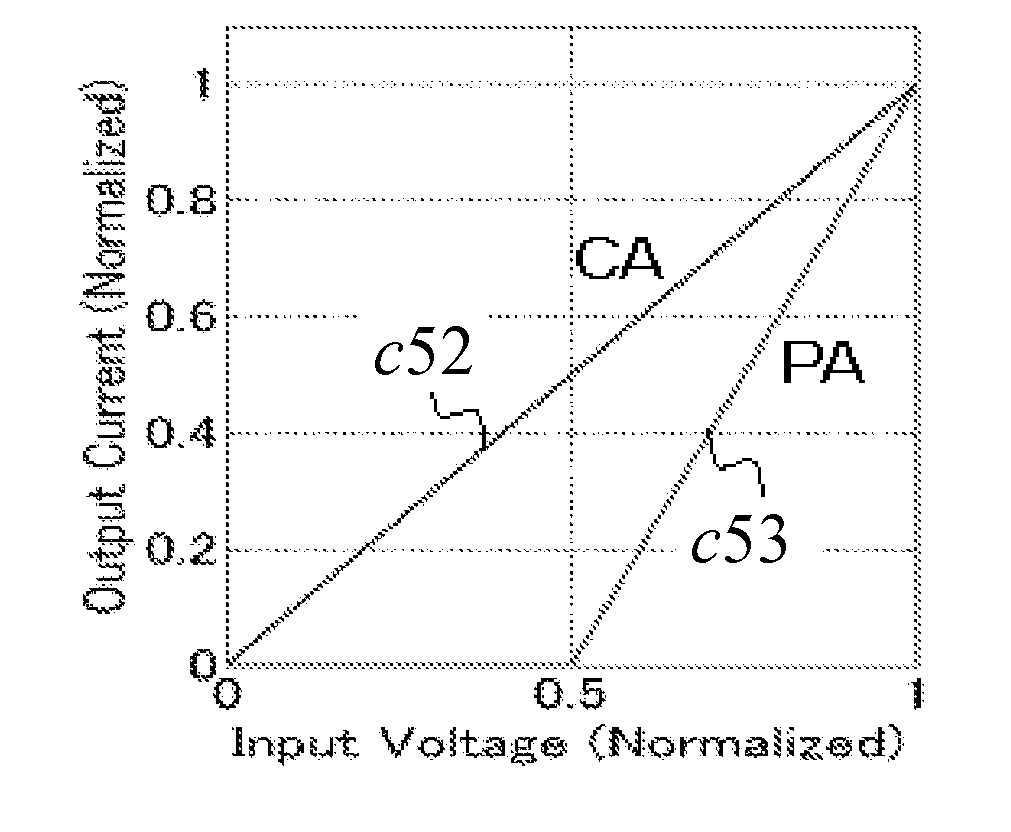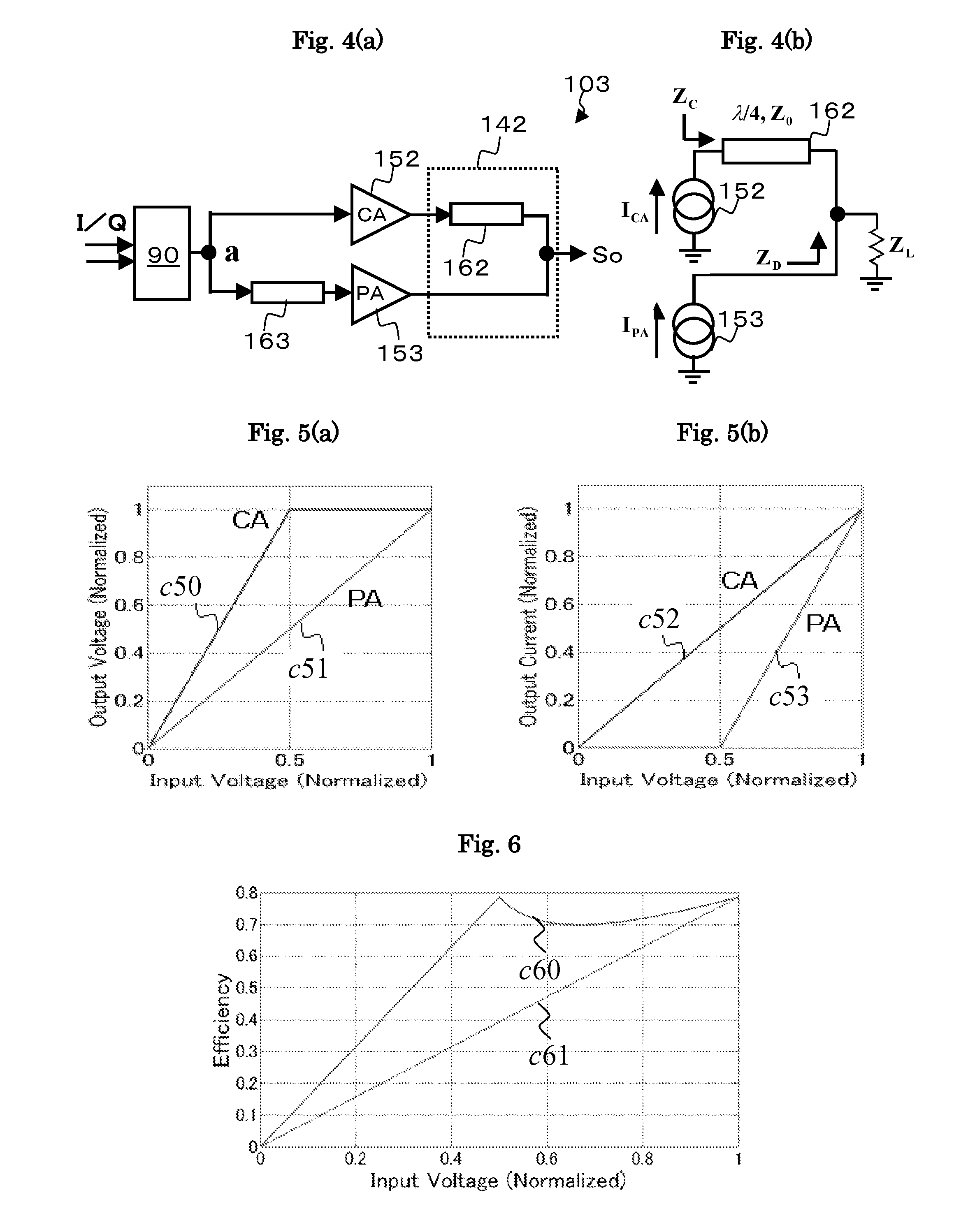Linear Composite Transmitter Utilizing Composite Power Amplification
a technology of composite power amplifier and linear amplifier, which is applied in the direction of digital transmission, secret communication, baseband system details, etc., can solve the problems of limiting the ability to achieve both a good power efficiency and a good psd characteristic over a wide frequency bandwidth, and achieve the effect of improving power efficiency
- Summary
- Abstract
- Description
- Claims
- Application Information
AI Technical Summary
Benefits of technology
Problems solved by technology
Method used
Image
Examples
embodiment 1
[0131]Referring to FIG. 10, there is shown a composite transmitter 201 according to the invention, which comprises the following three components.
[0132](1) A signal component separating device 80 which, upon receipt of an in-phase baseband signal I(t) and an orthogonal baseband signal Q(t), outputs[0133]a first composite signal S1(t) in the form of a vectorial sum of[0134]a main signal A(t) obtained by orthogonal modulation of the in-phse signal I and the orthogonal signal Q and[0135]an efficiency improving signal (EIS) obtaind from the main signal by subjecting the main signal to frequency shifting and envelope conversion, and[0136]a second composite signal S2(t) in the form of a vectrial difference between the main signal and the EIS;
[0137](2) A first power amplifier 50 for power amplifying the first composite signal S1(t) and a second power amplifier 51 for power amplifying the second composite signal S2(t); and
[0138](3) A power combiner 40 having a symmetric structure for combin...
embodiment 2
[0150]The composite transmitter 202 (not shown) is a modified version of a conventional Chireix transmitter (FIG. 3), modified in such a way that, the signal component separating device provides:
[0151]a phase determination signal u(t) (simply referred to as u) which equals +1 if the main signal has a phase in the range between θ0−π / 2 and θ0+π / 2 but equals −1 otherwise, where θ0 is an arbitrarily set phase, and provides an EIS (Eq. 4), whose vectrial form is given by the following equation
jb=jb(t)exp{φ(t)} (Eq. 18)
where b(t)=√{square root over (C2−a(t)2)}, and C is the peak envelope level of the main signal.
[0152]A first and a second vectorial composite signals S1 and S2, respectively, given by Eqs. 19 and 20, respectively.
S1=a+jub (Eq. 19)
S2=a−jub (Eq. 20)
[0153]Denoting the main signal by I+jQ and the EIS by Iz+jQz, and defining the quantity b(t) / a(t), or √{square root over (C2 / a(t)2−1)} as envelope conversion signal, the in-phase signal Iz of the EIS turns out to be a product ...
embodiment 3
[0161]The inventive composite transmitter 203 (not shown) is a modification of the Doherty transmitter 104 obtained by replacing the Doherty's power combiner 142 with a structurally symmetric power combiner 40. With the EIS vector a1 given by Eq. 22,
a1=a(0≤a(t)≤C / 2)={C / a-1}a(C / 2≤a(t)≤C)(Eq.22)
The first composite signal S1 which is a vectorial sum of the main signal, the phase determination signal u, and the EIS and the second composite signal S2 which is a vectorial difference between the main signal and the EIS are given by the following Eqs. 23 and 24, respectively.
S1=a+ua1 (Eq. 23)
S2=a−ua1 (Eq. 24)
[0162]In order to narrow the frequency bandwidth of the EIS of the composite transmitter 203, it is also important for an improvement of its ACLR characteristic to reduce the spectral regrowth power density. FIG. 15 shows behaviors of the main signal A, the EIS ua1 the first composite signal S1, and the second composite signal S2 on the phase plane referenced to the carrier frequenc...
PUM
 Login to View More
Login to View More Abstract
Description
Claims
Application Information
 Login to View More
Login to View More - R&D
- Intellectual Property
- Life Sciences
- Materials
- Tech Scout
- Unparalleled Data Quality
- Higher Quality Content
- 60% Fewer Hallucinations
Browse by: Latest US Patents, China's latest patents, Technical Efficacy Thesaurus, Application Domain, Technology Topic, Popular Technical Reports.
© 2025 PatSnap. All rights reserved.Legal|Privacy policy|Modern Slavery Act Transparency Statement|Sitemap|About US| Contact US: help@patsnap.com



